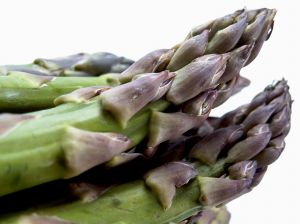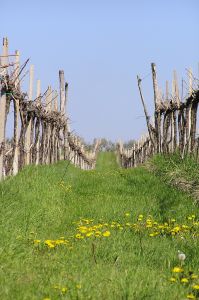Wally Richards – Planting Asparagus and Winter Pruning
Filed in Gardening & Maintenance, Organic Gardening, Vegetable Gardening on June 27, 2009 with 11 comments

Asparagus is a favorite seasonal vegetable for many gardeners and gourmets. Bountiful too – once established, mature crowns produce many delicious spears each spring. I spoke to a elderly lady gardener recently who told me that she had a bed of asparagus that is now 30 years old and still producing an abundance of spears every season. What a great asset to have in ones garden!
Asparagus crowns become available about this time each year in your local garden centres and it’s a good idea to obtain them as soon as available as they are best when freshly dug. If you wish to move an existing asparagus bed to a new location, now is also the best time to do so as the ferns will be yellowing off and they can be cut down and the crowns lifted. Try to do so with as little root disturbance as possible which is a bit difficult as they do create a strong root system over time.
Asparagus is best grown from crowns which are replanted in mid winter when the plants are dormant. They can be grown from seed, but you are looking at an extra two to three years to get up to the crown purchase stage. Check that the crowns purchased are in moist material as if they dry out for too long they may fail.
Planting
Prepare a raised bed in a sunny spot that will be a long term asparagus plot. The bed should be a mix of soil, compost and animal manure. Apply Rok Solid, Ocean Solids and BioPhos to the bed and give annual dressing of the three each winter. Lay the crowns with their roots fanned out on top of the bed about 150mm apart then cover with compost. Keep moist through the drier times.
Care and Harvesting
The first season slender stalks will appear with their fern-like foliage. These are left untouched until they die back the following winter. The foliage will gain energy from the sun and strengthen the crowns and root systems. Each winter, if possible, spread seaweed over the bare bed after applying a mulch of compost and animal manure.
The second season you can harvest the good size spears for about a week, and then allow to go to fern. The following season you may harvest for about two weeks before allowing to fern. The fourth season should allow about 3-4 weeks harvesting and after that the harvest time can be between 6 to 8 weeks.
Harvest the spears by bending them so they snap off at ground level. If berries form on the ferns, these can be removed as they are seeds which may become a weed problem. Control of insect pests can be done with Neem Tree Granules or sprays of Neem Tree Oil.
Winter Pruning
Now is the time to do any winter pruning of deciduous fruit trees, grapes and berry bushes. Always pick a nice sunny day to prune when the air is drier. Cold moist weather can carry the dreaded silver leaf disease which can easily enter the cuts and infect some fruit trees and roses. To go through all the different types of pruning for various plants is difficult to do in this column so let’s focus on grapes and fruit trees.
Pruning Grape Vines

Allow the grape vine to grow any-which-way the first year it is in the ground. Having abundant stems and leaves will help develop a strong root system on immature grape vines. Do not prune at all for the first year.
The first winter: Select the strongest and most vigorous-looking stem during the winter of the first year. Using bypass pruners, remove all the other stems at the base of the plant or as close to the trunk on the main stem as possible. Stake the remaining stem which will become the trunk of the plant. Use a grape stake or secure the vine along a fence with wire.
Second spring: Allow stems to grow from the main trunk. In the spring of the second year, begin removing all but two of the very best side shoots that grow from the trunk. If the vine isn’t branching where you want it too, pinch the top of the main trunk to encourage side branching.
Second Summer: Cut back the top of the trunk during midsummer of the second year, when the vine reaches the desired height. The process of tip pruning will force new growth along the main trunk. Remove any new branches that don’t fit your plan.
Second Winter: Cut back all but the desired side branches and the main trunk during the second winter. What you have now is the basic frame for the plant – an upright stem with two sets of side branches. Allow the vine to grow during the third spring and summer, removing anything that grows from the trunk. You want to retain the basic framework of the vine.
Third Winter: Leave 12 buds along each of the arms during the third winter. Pruning during the third winter is crucial to future fruit production. These 12 are the buds that will produce fruit during the 4th summer. Each of the 12 should have 1-2 leaf joints so that the vine looks like a stubby hat rack when you are finished pruning. These are called ‘renewal buds’ and will remain on the plant forever. Prune the 12 renewal buds so that there is always one more bud growing from the tip.
This practice will continue from the fourth winter onward. What you are doing is allowing the renewal buds to extend and grow one bud length every season. During the summer, the fruit develops on the new growth that springs from the renewal bud. Keeping them short during the dormant season keeps the plants under control.
Pruning fruit trees
This is an important routine employed by gardeners to control growth, remove dead or diseased wood or stimulate the formation of flowers and fruit buds. The most economical pruning is done early in the season, when buds begin to break, and one can pinch off the soft tissue with one’s fingers (hence the expression “nipped in the bud”).
Many home fruit growers make the mistake of planting a tree, then neglecting it until it begins to bear. But careful attention to pruning and training young trees will ultimately determine their productivity and longevity. Good pruning and training will also prevent later injury from weak crotches that break under snow or fruit load.
For further information on fruit tree pruning try http://en.wikipedia.org/wiki/Pruning_fruit_trees. This gives some good basic information on what to do with new fruit trees and also with established fruit-bearing ones for best results. They have good pictures and diagrams to assist.
Problems ring me at 0800 466464 (Palmerston North 3570606)
Email wallyjr@gardenews.co.nz
Web site www.gardenews.co.nz


We are harvesting in our asparagus bed’s 3rd year. Is it best to harvest all spears for the first 4 weeks (even the stringy skinny tall ones) or should we leave the skinny ones?
I planted some asparaugus roots this last spring and now have the ferns growing close to a foot high. How low should I trim this dow before winter sets in , or should I just leave them alone and let nature do its thing ?
Mike
Hi Where are you based? – its spring here in NZ.
I planted asparagus roots this spring. Now with winter near,should I trim the ferns back or just leaave them till forst kills the ferns?
how do you prepare asperagus plants correctly for winter the plants have been in for two seasons now and I intend harvesting them next spring
I have a punga tree beside the house that has go too tall. Can I cut it off about half way down and will it regrow from the trunk top again?
I have a friend living right on the coast just south of westport in an exposed site. She recently prepared a veggie garden, the soil is very sandy and she added seaweed, biomix and some nitrophoska blue. When she planted various seedlings they survived for a short period and then the leaves turned black and the plants died. 1 lettuce did survive. What would be the cause of this and what can she do to prevent it from happening.
Hi Gillie,
It is a possibility that too much fertiliser has been added to the soil – too rich and the roots have been burned. The best way to enhance sandy low humus soil is to add good quality organic compost or even some weed free soil and mulch. Nitrophosca blue should be used sparingly on seedlings. Better to use sheep pellets and blood and bone mix – good compost is best.
I hope that helps.
Regards
Tim Durrant – Editor
Wally,
We planted asparagus plants in the spring and want to know how to prepare them for winter.
Thanks, Lee
Sorry, email was misspelled. It is correct now.
There is some good advice here:
http://www.howtogardenadvice.com/vegetables/grow_asparagus.html